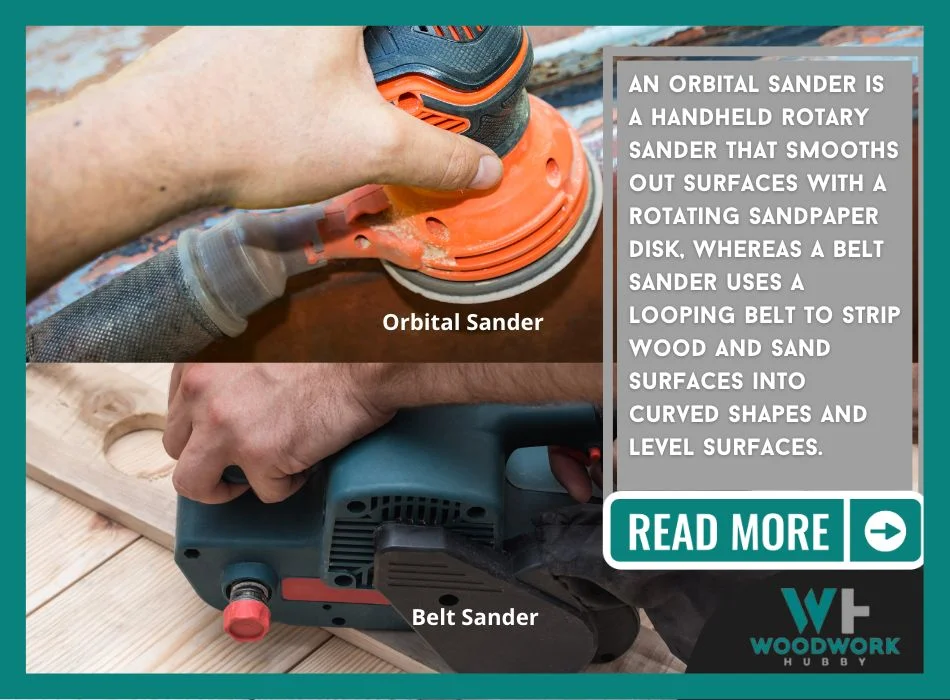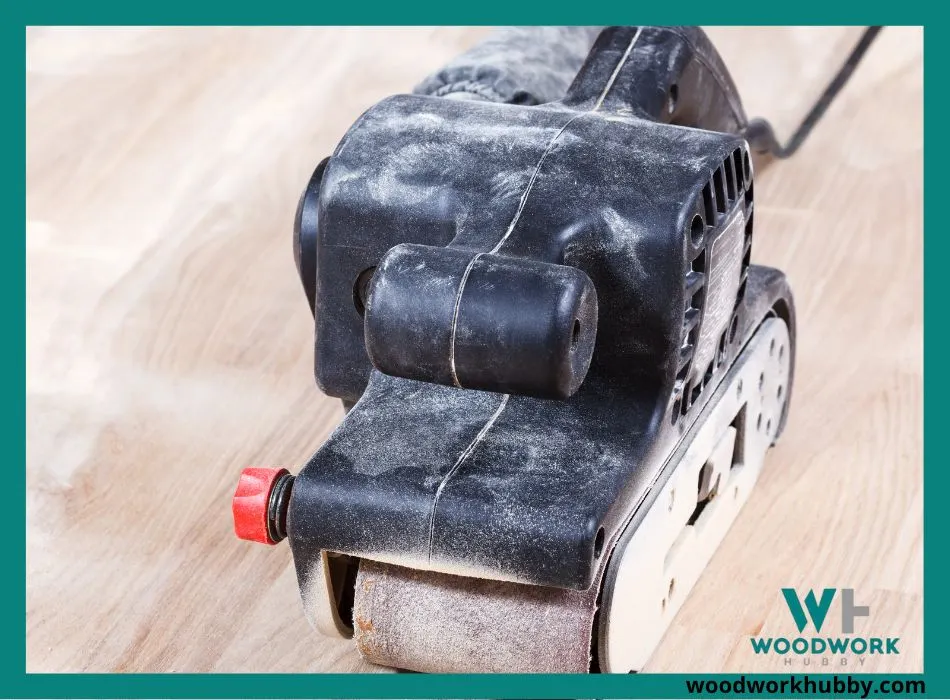Today, my wife said commented on why I had so many sanders. She took a look at the two sanders placed in the corner and asked if I could do with just one. “Of course, I need both! One is an orbital sander, and the other one’s a belt sander. So what is the difference between an orbital sander and a belt sander?
An orbital sander is a handheld rotary sander that smooths out surfaces with a rotating sandpaper disk, whereas a belt sander uses a looping belt to strip wood and sand surfaces into curved shapes and level surfaces.
In this article, you will learn more about the key differences not just in form but also in the function of orbital and belt sanders. You will also discover the two types of belt sanders that have drastically different functions and which sander you should use for which type of job.
See The Sanders I Use 💭
I have listed the belt sander and Orbital sanders that I use and recommend below. Jump to them by clicking here.
By the end of this post, you’ll know which type of sander is best for you and which specific sander you should get. But before we get into product recommendations, let’s look at product differences.
What Are The Differences Between An Orbital Sander And A Belt Sander?
The main differences between an orbital and a belt sander are in the sanding motion and the results of sanding. An orbital sander rotates a sanding disk, while a belt sander has a belt that revolves between two points, stripping the material pushed against it.

An Orbital Sander Rotates
The difference in sanding motion starts with how both sanders move. The orbital sander moves in a short circular motion. This means whatever part gets rubbed once gets rubbed again in a very short period. This kind of sanding action makes the area of effect much smoother.
A Belt Sander Moves Lengthwise.
Where the orbital sander rotates, a belt sander moves like a conveyer belt or a treadmill belt. It goes lengthwise between two points. The effect of sanding with a lengthwise sanding strip is that the material that gets sanded is under constant one-way erosive pressure.
As a result, it can lose its upper layer to the belt sander without being smoothened out.
A belt sander’s constitution makes it more apt at digging out the surface instead of making it smoother. That said, the pressure with which the wood is held against the sander plays an important role too.
Which Is Better, A Belt Sander Or An Orbital Sander?
A belt sander is better for strip jobs, while an orbital sander is better for smoothening out a rough surface. An orbital sander has less interchangeability compared to a belt sander, which can, in some cases, be used for the same effect as a belt sander.
I personally own both sanders because neither sander is superior enough to replace the alternative completely. Most woodworkers I know have the same approach as well. Power sanders are usually meant for heavier action, which is why if you are confined to a single purchase, you should probably get a belt sander.
It can do the heavy sanding work, and you can execute the smoothing jobs by hand.
In terms of action effect, the lowest sanding impact is from a hand sander, with orbital sanders being a step-up.
Finally, the heaviest stripping effect is attributed to the belt sander.
Within each sanding option, you can vary the intensity of the effect.
With a sanding block, you can alter the sanding paper grit to match the effect you want. Use a 180 to 220 grit sandpaper to get a smoother finish and a 40 to 60 grit sandpaper to strip paint or finishing coat from the wood’s surface.
Aside from changing the grit of the sandpaper, you can also alter the pressure and speed of sanding.
You can push an orbital sander harder against the wood to strip it instead of smoothening it. You can also decrease the pressure with which you hold the wood against a sanding belt to reduce the stripping effect.
While you can manage the intensity of sanding by pressure and speed variation, the methods themselves have limits.
There’s only so much ‘smoothing’ that can happen with a belt sander and ‘stripping’ that can happen with an orbital one. That’s why I recommend different methods for different jobs.
Which Sander I Recommend For What Jobs
I have three types of power sanders in my shop, and I use all of them, albeit for different types of work. Having done so for over a decade, I can confidently recommend them for different jobs.
Here are the different sanding tools and which jobs I recommend them for:
- Orbital Sander – For a super smooth finish on wood or plastic. Sometimes, it can be used to smoothen metal as well.
- Bench Belt Sander – To do an orbital sander’s job on a larger scale. This sander isn’t too rough and doesn’t strip wood as much as a hand belt sander.
- Hand belt sander – To sand super rough surfaces, level surfaces with deep crevasses, and for rounding and shaping jobs. Ultimately, it is for rapid wood stripping.
In the above three classifications, you can see that there are two belt sanders and one orbital one. However, the belt sanders are less alike because their sanding speed and scale affect their overall outcome.
Hand Belt Sander And Bench Belt Sander
Any discussion about belt sanders would be incomplete without discussing the two subtypes of belt sanders.

A hand belt sander is a handheld sanding device that can be used to strip and shape wood while a benchtop belt sander is a stationary sanding device with a belt that runs across its pivot points. It is used to smooth out longer wood and metal pieces.
A benchtop sander is more expensive, naturally, because it is a larger piece of equipment. That doesn’t make it superior in all areas. A handheld belt sander is much better at creating curved shapes, for instance, because it can be held at different angles.
For the most part, I consider a benchtop sander to be closer to an orbital sander in most things besides the scale. It produces a smoothening and leveling effect on part with an orbital sander. It is just not that fine in the level of smoothing.
Pros And Cons Of Different Types Of Sanders
You need more than one sander in your workshop because one sander’s advantage can be another’s disadvantage.
Knowing the pros and cons of different sanders can help you avoid disappointment by selecting the right one for the job. Refer to the table below to figure out the pros and cons of different sanders.
| Pro/Con | Orbital Sander | Handheld Belt Sander | Benchtop Belt Sander |
|---|---|---|---|
| Pro | Produces the smoothest finish | Best at high-precision curves and rounding | Covers a large area in less time |
| Con | Takes a long time to cover a large area | It can be heavy | You don’t get to maneuver or move it |
| Pro | Easy to change sanding disks | It is fast at stripping and sanding material. | Helps remove paint residue |
| Con | Sanding disks can be hard to find | Fails against already smooth material | It can lack versatility in some cases |
| Pro | Variable speeds available in many models | It can be used for smoothening and stripping | It is easier to use |
| Con | The sander can have a tough time holding the disks | It can be too aggressive for expensive timber | It can’t handle all your sanding needs |
Sanding Block: A Backup Worth Having
While these sanding tools have their place, you should never be without a sanding block, especially if your choice of power sander leans on the aggressive side. There is nothing like a sanding block when it comes to having control over a soft-sanding process.
You need a sanding block, especially if your choice of electric sander is a belt sander. And I actually recommend making the handheld belt sander your first electric sander purchase. But if you get it and don’t have a sanding block for lighter sandjobs, you will find the device limiting.
Which Sander Should I Get?
Ideally, you should have both sanders but if you have to choose one, go with the handheld belt sander because its main value is in its aggressive sanding, which you cannot get from a hand sander. A disc sander’s smoothening function can be done with a sanding block as well.
So going purely by what a power sander is really needed for, I would prioritize a belt sander over an orbital one. Still, I would get both sanders eventually.
Best Handheld Belt Sander
Makita 9403 Belt Sander
This belt sander is of high quality and is my pick of the belt sanders that are on the market. It is great for removing excess material quickly and you can buy different grits for the belts to achieve finer sanding.
What I Like
- Excellent build quality
- 4-inch wide belt for flatter sanding
- Easy belt-changing mechanism
- Sanding belt size is common
- Very quiet
What I Don’t Like
- A little heavy to lift
- The dust bag is messy
- It’s not brushless
- Hard to see when sanding
Best Orbital Sander
Dewalt Random Orbital Sander
This orbital sander is my top pick when it comes to orbital sanders. It is by no means the best of the market but would fit into the shops of most intermediate and some advanced woodworkers.
What I Like
- Easy sanding disk changes with hook and loop system
- Light and easy to handle
- Little vibration
- Very quiet
What I Don’t Like
- Dust port is not a standard size
- Hook and loop pad wears quickly
- On Off switch is small
How To Use Your Electric Sanders Together
Every now and then, you will start a project to create a cabinet, bed frame, or something similarly elaborate. That’s when having multiple sanders will give you the most value. But if you use the sanders in the wrong order, it will turn into a headache.
You should use a belt sander first to strip and shape wood. Once the surface is ready and just needs to be smoother, you can use the orbital sander to bring it closer to the desired finish.
Generally, a surface that isn’t conducive to sanding is easier to sand with an orbital sander (at low surface-contact pressure). Such material shouldn’t be subjected to a belt sander. You should use the orbital sander directly in such cases.
Final Thoughts – Orbital vs Belt Sander
An orbital sander is better at finishing, while a belt sander is better at shaping wood. Both sanders are good for different types of jobs, but an orbital sander is easier to replace with a sanding block than an aggressive belt sander.
That’s why you should get a handheld belt sander if you can invest in only one type of electric sander.






